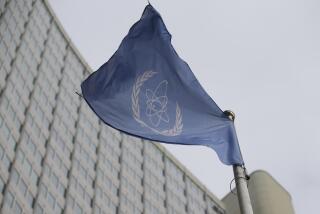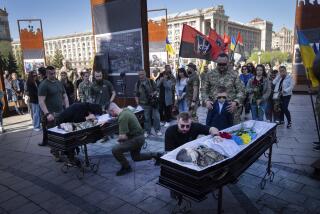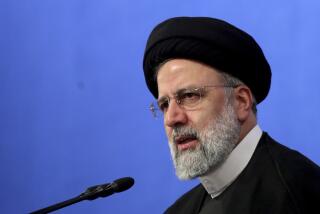U.N. nuclear agency expresses concern on Iran
Reporting from Vienna and Beirut — The United Nations’ nuclear watchdog for the first time Thursday explicitly voiced concern that Iran is trying to make a nuclear bomb, amid signs of fraying relations between the agency’s inspectors and authorities in the Islamic Republic.
The International Atomic Energy Agency confirmed that Iran last week produced its first batch of 20% enriched uranium, based on scientific data it was given by Iranian officials who plan to use the more highly purified nuclear fuel at a Tehran medical reactor.
The IAEA also said it had not yet resolved questions about documents that suggest Iran was engaged in experiments consistent with a clandestine nuclear program. Iran has called the documents forgeries.
“The information . . . raises concerns about the possible existence in Iran of past or current undisclosed activities related to the development of a nuclear payload for a missile,” the report said.
Iran ignored such language and said the report, the first under new IAEA chief Yukiya Amano, affirmed the civilian nature of its nuclear program.
“The new director-general of the IAEA has confirmed that Iran’s nuclear activities are peaceful and that there are no deviations in material or activities toward military purposes,” Ali Asghar Soltanieh, Iran’s nuclear envoy, told state news media.
U.S. officials said the report was in line with their concerns about Iran’s nuclear activities.
White House Press Secretary Robert Gibbs said the report demonstrates “the failure of the Iranian government to live up to its international obligations.”
Iran insists its program is wholly for peaceful purposes. The U.S. and its allies strongly suspect Iran seeks to build a nuclear weapon.
Iran’s current stock of 3.5% enriched uranium can fuel a power reactor, while rates of 60% purity are required to serve as fissile material for a nuclear bomb. Western officials had doubted Iran’s claims that it had produced the more highly refined uranium but warned that such a step would escalate tensions. A United Nations-backed offer to swap Iran’s uranium for fuel plates for the reactor foundered.
The report said Iran had produced about 4,550 pounds of low-enriched uranium so far, which experts say is almost enough, when further processed, for two nuclear bombs.
On Sunday, Iran moved almost all of its enriched uranium to the site producing the 20% uranium, raising suspicions that it might plan to convert far more of its stockpile into higher-grade material than necessary for the medical reactor.
Though Iran has promised to never withdraw from the IAEA-monitored Nuclear Non-Proliferation Treaty, the report suggested new frictions with the agency.
“In its factual presentation, [the IAEA] has once again shown the lack of cooperation on the part of Iran,” said a Western diplomat in Vienna, where the agency is based, speaking on condition of anonymity.
The IAEA report took Iran to task on several counts, but mostly over a disagreement on whether Iran must abide by an annex to the treaty requiring more transparency.
It accused Iran of producing the 20% enriched uranium without inspectors present and after the agency had asked to install more surveillance equipment.
On Dec. 2, the IAEA asked Iran to clarify its stated intention to build 10 new enrichment plants and requested that it provide details of new facilities as required by international law.
Iran responded 15 days later that it had suspended its adherence to that rule in 2007 and it would “provide the agency with the required information if necessary.”
Iran also barred inspectors from taking samples of 756 barrels of heavy water discovered by the IAEA last fall at the Esfehan conversion facility. The plutonium in the spent fuel of heavy-water nuclear reactors can be used to make atomic bombs.
Iran says it made the material itself, but some analysts suspect it was secretly imported; Iran has refused to let inspectors have access its heavy-water production plant near Arak.
Satellite imagery shows the plant is running, the report said, even though the U.N. Security Council has told Iran to halt production.
Damianova is a special correspondent. Christi Parsons of the Washington bureau contributed to this report.
More to Read
Sign up for Essential California
The most important California stories and recommendations in your inbox every morning.
You may occasionally receive promotional content from the Los Angeles Times.










